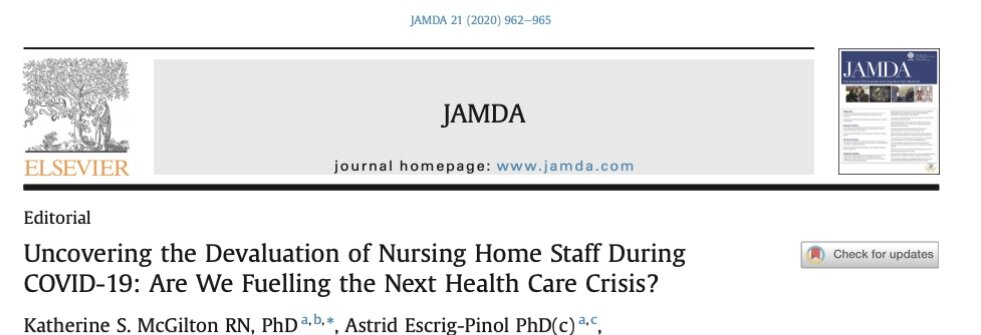Optimization of the Workforce
We have been working with a team of researchers focused on optimizing the long-term care (LTC) home workforce.
Nurse Practitioners in Long-Term Care homes
-

Complexity of Nurse Practitioners’ Role in Facilitating a Dignified Death for Long-Term Care Home Residents during the COVID-19 Pandemic
Vellani, Shirin; Boscart, Veronique; Escrig-Pinol, Astrid; Cumal, Alexia; Krassikova, Alexandra; Sidani, Souraya; Zheng, Nancy; Yeung, Lydia; McGilton, Katherine S.
Due to the interplay of multiple complex and interrelated factors, long-term care (LTC) home residents are increasingly vulnerable to sustaining poor outcomes in crisis situations such as the COVID-19 pandemic. While death is considered an unavoidable end for LTC home residents, the importance of facilitating a good death is one of the primary goals of palliative and end-of-life care. Nurse practitioners (NPs) are well-situated to optimize the palliative and end-of-life care needs of LTC home residents. This study explores the role of NPs in facilitating a dignified death for LTC home residents while also facing increased pressures related to the COVID-19 pandemic.
-

One Solution to the Long-Term Care Crisis: Nurse Practitioners
Katherine McGilton, Dana Cooper
The pandemic has brutally exposed vulnerabilities in long-term care (LTC) homes, but one solution is hiding in plain sight – nurse practitioners, or NPs. The majority of residents of today’s LTC homes are frail, have multiple chronic health conditions, and are in mid to advanced stages of dementia, all of which lead to unpredictable and complex care that requires knowledgeable assessments and interventions by qualified health-care providers. And COVID-19 has underlined the importance of having on-site clinicians available to provide expert assessments, care and timely follow-up as well as the ability to work collaboratively with staff to deliver the care that was planned.
-

A hidden solution for the long-term care crisis: U of T nursing expert to study nurse-led interventions
University of Toronto News
“Since the pandemic struck, we have seen nurse practitioners (NP’s) expand their role in long-term care to provide support to management, staff, residents, and families, as well as offer in-person care, and expertise on infection prevention control,” says McGilton who is also a Scientist at the KITE Research Institute at University Health Network. “NP’s are ideally placed to implement recommendations from researchers to keep long-term care homes Covid-19 resilient.”
-

Uncovering the Devaluation of Nursing Home Staff During COVID-19: Are We Fuelling the Next Health Care Crisis?
Katherine S. McGilton, Astrid Escrig-Pinol, Adam Gordon, Charlene H. Chu, Franziska Zúñiga, Montserrat Gea Sanchez, Veronique Boscart, Julienne Meyer, Kirsten N. Corazzini, Alessandro Ferrari Jacinto, Karen Spilsbury, Annica Backman, Kezia Scales, Anette Fagertun, Bei Wu, David Edvardsson, Michael J. Lepore, Angela Y.M. Leung, Elena O. Siegel, Maiko Noguchi-Watanabe, Jing Wang, Barbara Bowers.
As the COVID-19–related mortality rate of nursing home residents continues to rise, so too will the rates of mortality and morbidity of staff who care for them, a problem we must address now to avoid another health care crisis once this pandemic recedes. Currently, a significant proportion of deaths are attributed to persons living in nursing homes, ranging from 42% to 57% in European countries reporting data, to as high as 82% in several U.S. states and in Canada.
-

Nurse Practitioners in Long Term Care Homes in the Time Of COVID-19: A Qualitative Study
Katherine McGilton, Alexandra Krassikova, Shirin Vellani, Souraya Sidani, Veronique Boscart, Andrea laboni, Lydia Yeung, Alexia Cumal, Nancy Zheng, Astrid Escrog-Pinol
COVID 19 outbreak-imposed lockdowns in long-term care (LTC) alienated residents, leaving them without care-partners and recreational activities Nurse Practitioners (NPs) are highly skilled healthcare providers with the ability to independently diagnose and treat patients In Canada, NPs provided care to residents in LTCHs, while physicians and specialized services limited their care mostly to virtual care.
Funding
Project title: Nurse Practitioners in Nursing Homes in the Time of COVID-19 Funding program: Maria and Walter Schroeder Foundation Funding period: May 2020 to Dec 2020 Principal investigator: Katherine S McGiltonCo-investigator(s): Souraya Sidani, Veronique Boscart, Astrid Escrig Pinol, Andrea Iaboni, Shirin VellaniKnowledge user(s) and other partner(s): Michelle Acorn, Claudia Mariano
-

Nurse Practitioners Rising to the Challenge During the COVID-19 Pandemic in Long-Term Care Homes
Katherine S McGilton, Astrid Escrig-Pinol, Veronique Boscart, Souraya Sidani, Andrea Iaboni, Shirin Vellani, Astrid Escrig-Pinol
There is an urgency to respond to the long-standing deficiencies in health human resources in the long-term care (LTC) home sector, which have been laid bare by the Coronavirus Disease 2019 (COVID-19) pandemic. Nurse Practitioners (NPs) represent an efficient solution to human resource challenges. During the current pandemic, many Medical Directors in LTC homes worked virtually to reduce the risk of transmission. In contrast, NPs were present for in-person care. This study aims to understand the NPs’ roles in optimizing resident care and supporting LTC staff during the pandemic.
-

Factors Influencing Nurse Assistants’ Job Satisfaction in Nursing Homes in Canada and Spain: A Comparison of Two Cross-Sectional Observational Studies.
Katherine S. McGilton, Steven Stewart, Jennifer Bethell, Charlene H. Chu, Jose T. Mateos, Roland Pastells-Peiró, Joan Blanco-Blanco, Miriam Rodriguez-Monforte, Astrid Escrig-Pinol, Montserrat Gea-Sánchez
Objectives: To access associations between job satisfaction and supervisory support as moderated by stress.
Methods: For this cross-sectional study, data collected from 591 nursing assistants in 42 nursing homes in Canada and Spain were analyzed with mixed-effects regression.
Discussion: Stress was associated with lower job satisfaction and moderated the association of supervisory support and job satisfaction, reinforcing the importance of supervisors supporting nursing assistants, especially during the COVID-19 pandemic.
-

Organization of work and decision making of professionals working in nursing homes in Catalonia (Spain)
Gea-Sanchez, M, Teres-Vidal, L, Alcondada-Romero, A., Patells-Peiro, R, Blanco-Bianco, J., McGilton, K
The long term care environment demands specific requirements of the staff, namely that they provide a holistic approach to care. Providing holistic care leads to complex decision-making processes which go beyond just finding a solution to a specific health problem. It requires that staff are able to respond to the diverse needs expressed by the residents and which, in many cases, are only identified through the relationship that professionals have with them. However, this relationship that staff establishes with the resident often leads to burden for these professionals.
-

Factors Associated With Nurses' Job Satisfaction In Residential Long-term Care: The Importance of Organizational Context
Alioso, L., Gifford, W., McGilton, K.S., Lalonde, M., Estabrooks, C. Squires, J.
We examined demographic, individual, and organizational context factors associated with nurses' job satisfaction in residential long-term care (LTC) settings. Job satisfaction has implications for staff turnover, staff health, and quality of care.
-

Unpacking the Multiple Dimensions and Responsibility Levels of the Charge Nurse Role in Long-Term Care
Escrig-Pinol, A., Hempinstall, M, McGilton, K.S.
The charge nurse in long‐term care facilities (LTCFs) performs a multiplicity of tasks that range from oversight of the entire facility to directly assisting residents in activities of daily living. In order to refine resident‐centred care strategies and to increase the quality of care provided in LTCFs, this study aims at gaining a more nuanced understanding of the different dimensions of the charge nurse role as a central figure in these institutions
-

Strategies to facilitate shared decision-making in long-term care
Cranley LA, Slaughter S, Caspar S, Heisey M., Huang M.,Killackey T, McGilton K.S.
The aim of this study was to explore shared decision-making among residents, their families and staff to determine relevant strategies to support shared decision making in long-term care (LTC).
-

Supportive Supervision and Staff Intent to Turn Over in Long-Term Care Homes
Bethell J, Chu CH, Wodchis WP, Walker K, Stewart SC, McGilton KS
To examine the association between supervisory support and intent to turn over among personal support workers (PSWs) employed in long-term care (LTC) homes in Ontario, Canada, by assessing whether the association is mediated by job satisfaction and the potential confounding effect of happiness.
The Supervisor in LTC Homes
-

Embodying person centered being and doing: Leading towards person centered care in nursing homes as narrated by managers
Backman, A., Ahnlund, P., Sjogren, K., Lovheim, H., McGilton, K.S., Edvardsoon, D.
Although a growing body of research knowledge exists highlighting the importance of leadership to promote person‐centred care, studies focused on nursing home managers' own descriptions of leading their staff towards providing per‐ son‐centred care is lacking
-

Advancing Long-Term Care Science Through Using Common Data Elements: Candidate Measures for Care Outcomes of Personhood, Well-Being, and Quality of Life
Edvardsson, D., Baxter, R., Corneliusson, L., Anderson, R., Beeber, A., Boas, PV., Corazzini, K., Gordon, A., Hanratty, B., Jacinto, A., Lepore, M., Leung, A., McGilton, K.S., Meyer, J., Schols, J., Schwartz, L., Shepherd, V., Skoldunger, A., Thompson, R., Toles, M., Wachholz, P., Wang, J., Wu, B., and Zúñiga, F.
To support the development of internationally comparable common data elements (CDEs) that can be used to measure essential aspects of long-term care (LTC) across low-, middle-, and high-income countries, a group of researchers in medicine, nursing, behavioral, and social sciences from 21 different countries have joined forces and launched the Worldwide Elements to Harmonize Research in LTC Living Environments (WE-THRIVE) initiative.
-

Recommended Common Data Elements for International Research in Long-Term Care Homes: Exploring the Workforce and Staffing Concepts of Staff Retention and Turnover
Zúñiga, F.,Chu, C*., Boscart, V. Fagertun, A, Gea-Sánchez, M., Meyer, J., Spilsbury, K., Devi, R., Haunch, K., Zheng, N., McGilton. K.S
The aim of this review is to develop a common data element for the concept of staff retention and turnover within the domain of workforce and staffing. This domain is one of four core domains identified by the WE-THRIVE (Worldwide Elements to Harmonize Research in Long-Term Care Living Environments) group in an effort to establish an international, person-centered long-term care research infrastructure. A rapid review identified different measurement methods to assess either turnover or retention at facility level or intention to leave or stay at the individual staff level.
-

Cross-cultural validation and psychometric testing of the supportive supervisory scale in Spanish
Álvaro Alconada-Romero, Gemma Horta-García, Montserrat Gea-Sánchez, Joan Blanco-Blanco, José T. Mateos, Steven C. Stewart, Eva Barallat-Gimeno, Katherine S. McGilton.
Sedentary behavior (SB) is currently considered a public health problem with a high cost of care. Evaluating SB is essential for prevention and early management of physical inactivity. The International Sedentary Assessment Tool (ISAT) is an instrument that has been developed to assess SB. The aim of this study was to carry out a cross-cultural adaptation and a psychometric analysis of the Spanish version of the ISAT. A cross-sectional study was conducted. A total of 432 participants were included in this study. A double forward method and a backward method were used to translate the ISAT.

